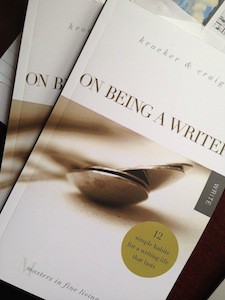Reading about one woman’s decision to create a uniform for herself in her work as an art director at an ad agency got me thinking about the importance of constraints in our creative lives. I began to imagine how freeing it would be to rid my mind of the daily decision of what to wear and how that energy could be redirected to push further into the creative work I do as a writer and editor. When I posted the link on Facebook, others affirmed my theory. “How simple this would make life, ” one friend said. “What a weight this would lift, ” said another. And, “Her logic makes sense!”
Viva la limits! I practically screamed at the laptop, as I began surfing for the perfect combination to concoct my own new uniform. I have been struggling to balance my workload and maneuver between my more creative work and the more straightforward tasks of my job. If reducing complexity would mean more streamlined productivity, then I wouldn’t stop with my wardrobe. We could eat the same food every day, shop at the same stores, watch the same shows on television. What else?
I couldn’t help but think of the simple sociological study I had read about years earlier that set out to determine the effects a fence around a playground would have on preschool children. The same group of children was taken to two playgrounds: one with a fence and one without. Here’s how researchers described the results: “The overwhelming conclusion was that with a given limitation, children felt safer to explore a playground. Without a fence, the children were not able to see a given boundary or limit and thus were more reluctant to leave the caregiver. With a boundary, in this case the fence, the children felt at ease to explore the space. They were able to separate from the caregiver and continue to develop in their sense of self while still recognizing that they were in a safe environment within the limits of the fence.” Of course writers and other artists aren’t preschoolers, but the application to creative life seemed obvious.
In fact, so many experts have lately begun extolling the virtues of constrained creativity that “working inside the box” is the new “thinking outside the box.” From time limits to word limits to resource limits, articles like this one from Fast Company actually suggest imposing limits on oneself in order to bust through writer’s block or move toward greater creative heights.
In his TED Talk, artist Phil Hansen describes new levels of artistry he accomplished once he learned to live with a neurological tremor in his hands, a condition he previously thought would end his career.
“Limitations may be the most unlikely of places to harness creativity, but perhaps one of the best ways to get ourselves out of ruts, rethink categories and challenge accepted norms, ” Hansen said. “And instead of telling each other to seize the day, maybe we can remind ourselves every day to seize the limitation.”
Yes. Seize the limitation. That’s what I thought a uniform would accomplish. But then, I read a few more of the comments in that Facebook thread.
“I would hate it, ” one woman said. “It would stifle my creativity … I’d also feel like a part of my self expression would die.” And then this: “I would doubt the creativity of an art director who was too lazy to dress with some flair. I know a lot of male art directors. They don’t wear the typical male ‘uniform’ either.”
While I was off building a fence around my own creativity, others were tearing the fences down around theirs. Limits can foster ingenuity and imagination, but they also apparently can stifle them. How do we balance the two?
A few weekends ago, my husband and I visited the Dream Cars: Innovative Design, Visionary Ideas exhibit at the Indianapolis Museum of Art. I entered the exhibit not really knowing much about concept cars and marveled at the shapes and features that seemed entirely impractical for actual highway driving: wheel covers that turned with the wheels, designs mimicking insects, see-through roofs, aerodynamics gone wild.
Who would actually drive one of these? I thought as we walked around snapping photos and marveling at the high gloss and extravagant details. Then I read more about the exhibit, about the purpose of concept cars. “The experimental, concept, or ‘dream’ car has long been a dynamic tool that allows designers to showcase and demonstrate forward-thinking automotive design ideas, ” one exhibit placard said. “Concept cards were not vehicles the public typically could purchase, but rather the testing ground for innovations that might find expression in automobiles purchased years, or even decades, later.”
In other words, concept cars were designed and created by people who refused to accept limits. I saw this same element of limit-pushing when we walked up one floor to the museum’s new acquisitions of cutting-edge fashion. When I started to ask, “Who would actually wear something like this?” it hit me. No one but runway models would don these dramatic fashions made with unusual materials and sporting features like deeply plunging necklines or unusual shapes that transformed the wearer’s body type. Just like no one would drive a dream car to work each day. But that wasn’t the point. In both cases, the designers were experimenting, questioning commonly accepted norms, thinking outside that proverbial box I was trying to climb back into.
The result? They didn’t erase the boundaries. They expanded them. And not just for themselves. That car modeled after a bug? That’s today’s minivan. The floor length polyester dress? That’s now the maxi skirt hanging in my closet. When anyone pushes against a limit, we all benefit. Without the existence of boundaries in the first place, they wouldn’t have known where to push. It’s like Phil Hansen said about his own artistic process: “It really became a moment of clarification for me that we need to first be limited in order to become limitless.”
It’s probably true that we all work within some limits; if nothing else, time is the one great constraint we all have in common. But most of us recognize many other limits in our lives, too. And we share a great many of those with others. Accepting our limits—or even imposing limits on ourselves—and working within them can be a great source of creative inspiration.
But occasionally, we all need to design our own version of a dream car, to climb over the fence or back out of the box, maybe even brush past the people crowding around the edge and see what’s just beyond.
I’m still thinking about the uniform, but I’m also thinking about buying a new car. And I have no doubt I’ll recognize elements in each that were once considering cutting edge.
Photo by Sara, Creative Commons license via Flickr. Post by Charity Singleton Craig, co-author of On Being a Writer: 12 Simple Habits for a Writing Life that Lasts.
Explore more on Creativity
Explore more on the Writing Life
_______________________
Is your writing life all it can be?
Let this book act as your personal coach, to explore the writing life you already have and the writing life you wish for, and close the gap between the two.
- Grammar for a Full Life Book Club: On Becoming Less Possessive - June 16, 2021
- Grammar for a Full Life Book Club: Chilling Out on the Grammar Rules - June 9, 2021
- Grammar for a Full Life Book Club: A Passive Voice - June 2, 2021


Donna Z Falcone says
Fascinating!
Donna Z Falcone says
Did you ever see the Big Bang Theory episode in which Sheldon added the limits of rolled dice to make all of his decisions for him about the simple things… which freed him up to be wildly productive in his research? This reminded me of that, among other things. https://www.youtube.com/watch?v=BVIjqd8DBGw
Charity Singleton Craig says
Donna – I did see that! Yes, I think there are a lot of things we “waste” our minds on, that were we to constrain ourselves, we would have much more creativity.
Jody Lee Collins says
As a classroom teacher whose repertoire has included various art projects over 20 some years I have encountered colleagues who bristle at the idea of showing children a finished product. “Let them make their own! Don’t show them what it should look like!”
However, I discovered over and over again when given a boundary for their work, or a target to aim for, their work was lovelier than if I’d handed them glue sticks, scissors and construction paper.
Borders are my best friend–drawn like windows on a blank page, they can hold a lot of creativity. When I asked some 2nd graders to design covers for their Bird Reports I showed them how to design with a Sharpie a simple wavy frame on the white paper….they did all the drawing from there.
As a very abstract person I need limits myself to know what to shoot for…. and the creativity seems to flow out of that.
Writing in a form like a pantoum (thank you Tweetspeak!) or with a pattern in art gives me the freedom to try.
Trying is the way to grow, I think.
Charity Singleton Craig says
Jody – How interesting about the model and the frames and the way you provide some boundaries for your students so that they can they push up close to them. I’m sure some of the students step right over the boundaries, too, but at least they know where they are stepping! Thanks for your experiences and thoughts on this.
Sandra Heska King says
I’m in a season right now where I need to set some boundaries in order to break some boundaries. It seems like there’s always some kind of encroachment. And then there’s the issue of deciding where those boundaries should actually be–and how flexible should they be…
Thinking about the boundaries of a page, a sheet of canvas, a tweet … and how our mind creates boundaries…
Charity Singleton Craig says
That’s an interesting comment, Sandy. That you need to create some boundaries in order to break through others. I think you are on to something. I think boundaries are a great way to shake off a lot of inefficiency or writer’s block or other hindrances. I think you are right that our mind naturally creates boundaries; I think that’s why imposing limits works.
Manish says
The Camera frame is boundary but it always expands the vision which is invisible to naked eye. And this will always stay such. The frame makes one compose an image yet transcend it beyond frame.